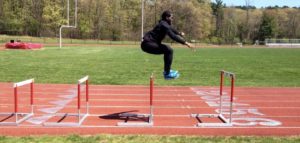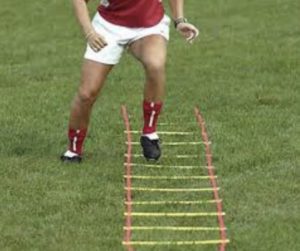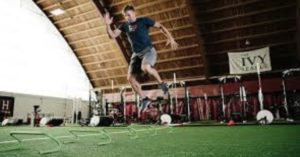. 2010 Oct;24(10):2670-6.
doi: 10.1519/JSC.0b013e3181e2728f.
Effects of in-season on leg power, jump- and sprint performance of soccer players
- PMID: 20844458
- DOI: 10.1519/JSC.0b013e3181e2728f
Abstract
Our hypothesis was that the addition of an 8-week lower limb plyometric training program (hurdle and depth jumping) to normal in-season conditioning would enhance measures of competitive potential (peak power output [PP], jump force, jump height, and lower limb muscle volume) in junior soccer players. The subjects (23 men, age 19 ± 0.7 years, body mass 70.5 ± 4.7 kg, height 1.75 ± 0.06 m, body fat 14.7 ± 2.6%) were randomly assigned to a control (normal training) group (Gc; n = 11) and an experimental group (Gex, n = 12) that also performed biweekly plyometric training. A force-velocity ergometer test determined PP. Characteristics of the squat jump (SJ) and the countermovement jump (CMJ) (jump height, maximal force and velocity before take-off, and average power) were determined by force platform. Video-camera kinematic analyses over a 40-m sprint yielded running velocities for the first step (VS), the first 5 m (V5m) and between 35 and 40 m (Vmax). Leg muscle volume was estimated using a standard anthropometric kit. Gex showed gains relative to controls in PP (p < 0.01); SJ (height p < 0.01; velocity p < 0.001), CMJ (height p < 0.001; velocity p < 0.001, average power p < 0.01) and all sprint velocities (p < 0.001 for V5m and Vmax, p < 0.01 for VS). There was also a significant increase (p < 0.05) in thigh muscle volume, but leg muscle volume and mean thigh cross-sectional area remain unchanged. We conclude that biweekly plyometric training of junior soccer players (including adapted hurdle and depth jumps) improved important components of athletic performance relative to standard in-season training. Accordingly, such exercises are highly recommended as part of an annual soccer training program.
Analysis By CORE Physical Therapy and Sports Performance, Dr Mark Rathjen PT DPT.
Countless studies have shown the plyo drills increase power, explosive power, jumping, sprinting and agility metrics greater than that of which traditional strength training alone cannot match. In the above study we short duration type plyo training and its measurable increases in performance during bi weekly workouts during in season soccer players. We do understand during season training will have to decreased in volume as to allow proper rest, and recovery. We can see a short duration program of 8 weeks is still more than enough time to have a measurable benefit.
At CORE Physical Therapy, we utilize various plyo drills and protocols we have developed over the last 2 decades. The strategies utilized will greatly depend on the type of athlete, position and sport of said athlete, and the recovery or deficits the patient is currently experiencing. With that information, we formulate the most efficient strategies to increase performance metrics and still allow adequate recovery.
Physical Therapy and Sports Performance PC, is owned and Operated by Dr. Mark
Rathjen and Dr. Claire Rathjen. CORE is a family owned business that has been established in
2015 and is proud to serve the greater Omaha metro area. We specialize in the treatment of athletes.
For More information, Please feel free to contact us https://coreomaha.com/contact/
Please feel free to follow us at https://www.facebook.com/COREomaha/
To get started https://coreomaha.com/getting-started/
For more Blog information https://coreomaha.com/blog/
CORE Physical Therapy and Sports Performance PC.
17660 Wright St, suites 9/10
Omaha, NE 68130
402-933-4027
Similar articles
-
Effects of In-Season Short-term Plyometric Training Program on Sprint and Jump Performance of Young Male Track Athletes.J Strength Cond Res. 2015 Aug;29(8):2128-36. doi: 10.1519/JSC.0000000000000860.PMID: 25647644 Clinical Trial.
-
Effects of 8-week in-season plyometric training on upper and lower limb performance of elite adolescent handball players.J Strength Cond Res. 2014 May;28(5):1401-10. doi: 10.1519/JSC.0000000000000279.PMID: 24149768 Clinical Trial.
-
Effects of a back squat training program on leg power, jump, and sprint performances in junior soccer players.J Strength Cond Res. 2009 Nov;23(8):2241-9. doi: 10.1519/JSC.0b013e3181b86c40.PMID: 19826302
-
Short-term Periodization Models: Effects on Strength and Speed-strength Performance.Sports Med. 2015 Oct;45(10):1373-86. doi: 10.1007/s40279-015-0355-2.PMID: 26133514 Review.
-
Effect of Plyometric Training on Vertical Jump Performance in Female Athletes: A Systematic Review and Meta-Analysis.Sports Med. 2017 May;47(5):975-986. doi: 10.1007/s40279-016-0634-6.PMID: 27704484 Review.
Cited by 20 articles
-
Does Function Determine the Structure? Changes in Flexor Hallucis Longus Muscle and the Associated Performance Related to Dance Modality: A Cross-Sectional Study.Medicina (Kaunas). 2020 Apr 16;56(4):186. doi: 10.3390/medicina56040186.PMID: 32316305 Free PMC article.
-
An Acute Bout of Self-Myofascial Release Does Not Affect Drop Jump Performance despite an Increase in Ankle Range of Motion.Sports (Basel). 2020 Mar 19;8(3):37. doi: 10.3390/sports8030037.PMID: 32204326 Free PMC article.
-
The Effects of Circuit Strength Training on the Development of Physical Fitness and Performance-Related Variables in Handball Players.J Hum Kinet. 2020 Jan 31;71:191-203. doi: 10.2478/hukin-2019-0083. eCollection 2020 Jan.PMID: 32148583 Free PMC article.
-
General versus sports-specific injury prevention programs in athletes: A systematic review on the effects on performance.PLoS One. 2019 Aug 29;14(8):e0221346. doi: 10.1371/journal.pone.0221346. eCollection 2019.PMID: 31465458 Free PMC article.
-
The Effectiveness of Progressive and Traditional Coaching Strategies to Improve Sprint and Jump Performance Across Varying Levels of Maturation within a General Youth Population.Sports (Basel). 2019 Jul 30;7(8):186. doi: 10.3390/sports7080186.PMID: 31366104 Free PMC article.



